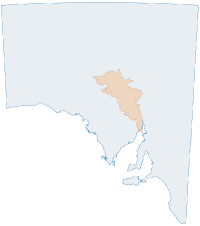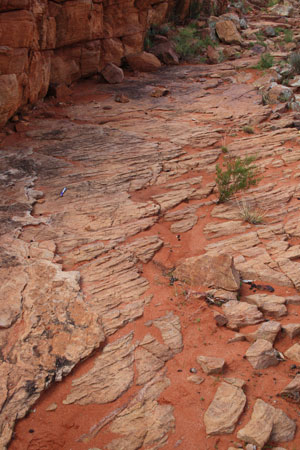 The Mesoproterozoic Cariewerloo Basin overlies the northeastern Gawler Craton and is infilled with fluvial redbed sediments, mainly sandstone. Equivalent rocks are not known elsewhere in South Australia.
The Mesoproterozoic Cariewerloo Basin overlies the northeastern Gawler Craton and is infilled with fluvial redbed sediments, mainly sandstone. Equivalent rocks are not known elsewhere in South Australia.
Age of major events
- Basin development: Early Mesoproterozoic (younger than 1575 Ma)
- Deposition of infilling Pandurra Formation: Early Mesoproterozoic (approximately 1424 Ma)
Prospective commodities
Metals: Cu, Au
Industrial minerals: Barite
Construction materials: Sandstone
Energy minerals: U3O8
Major exploration models
- Sediment-hosted Cu
- Unconformity and sandstone-hosted U
- Placer Au
Summary geology
The Cariewerloo Basin unconformably overlies a portion of the northeastern Gawler Craton and developed due to subsidence in the early Mesoproterozoic. This intracratonic basin is currently characterised as an elongate, 120 km wide, NW-trending basin bounded by major NW-trending faults bordering basement highs. Younger NE-trending faults disrupt the faulted eastern margin.
The Cariewerloo Basin is infilled with the Mesoproterozoic age Pandurra Formation which consists of unmetamorphosed, relatively undeformed, dominantly fluvial redbed sediments with a present thickness of up to 1500 m. Dickite crystal morphology suggests a total sediment thickness of around 3000 m. Consistent internal stratigraphy, regardless of depth to basement, suggests that deposition largely preceded the faulting that produced the present half-graben morphology. Sediment composition and limited paleocurrent data suggest sediments were derived largely from the then-elevated ~1592–1575 Ma Gawler Range Volcanics and Hiltaba Suite to the east of the Cariewerloo Basin. The age of sedimentation is bracketed by a c. 1490 Ma 40Ar-39Ar retention age of diagenetic illite (Beyer et al. 2018) and the age of the underlying Gawler Range Volcanics at ~1590 Ma.

Outcrop of coarse-grained, cross-bedded sandstone of the Pandurra Formation, Hotel Creek, Carriewerloo Station. (Photo 408221)
The Pandurra Formation is typically a medium to coarse-grained, poorly sorted, subangular quartz and lithic sandstone but also includes intervals of moderately well-sorted, very fine to medium-grained sandstone, granule to pebble conglomerates, mudstones and siltstones. The red, red-brown or purple matrix is dominated by illite, with varying amounts of hematite, kaolinite/dickite, sericite and muscovite. Remnant K-feldspar suggests that diagenesis was limited in some parts of the formation. In places the coarser members of the Pandurra Formation have undergone some reduction, displaying spotting or mottling in grey or white. Yellow or green reduction spotting is also observable in the interbedded mudstones and siltstones towards the lower part of the formation. Large-scale cross-bedding and liesegang banding are characteristic features of the formation.
Four informal members have been recognised within the Pandurra formation:
- The basal Member 1 consists of very poorly sorted, fine- to medium-grained, gritty, lithic sandstone, granular or pebbly sandstone and interbeds of mudstone and siltstone.
- Member 2 is a distinctive, widespread mudstone, micaceous sandy mudstone and micaceous siltstone, with interbeds of fine- to medium-grained sandstone with mudstone intraclasts common.
- Member 3 is typically a very fine to medium-grained sandstone, interbedded with variable amounts of mudstone and siltstone. Moderate to good sorting, subrounded to subangular quartz sand, heavy mineral layering and cross-bedding are characteristic of this member.
- Member 4 is a poorly sorted, cross-bedded, medium-grained to granular sandstone and pebbly sandstone. Thin interbeds of pebble conglomerate, mudstone, siltstone and fine-grained sandstone occur throughout the member. Heavy mineral layering is widespread but never abundant.


